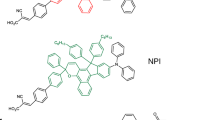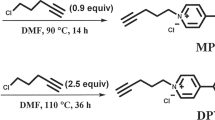Abstract
Solar cells that operate efficiently under indoor lighting are of great practical interest as they can serve as electric power sources for portable electronics and devices for wireless sensor networks or the Internet of Things. Here, we demonstrate a dye-sensitized solar cell (DSC) that achieves very high power-conversion efficiencies (PCEs) under ambient light conditions. Our photosystem combines two judiciously designed sensitizers, coded D35 and XY1, with the copper complex Cu(II/I)(tmby) as a redox shuttle (tmby, 4,4′,6,6′-tetramethyl-2,2′-bipyridine), and features a high open-circuit photovoltage of 1.1 V. The DSC achieves an external quantum efficiency for photocurrent generation that exceeds 90% across the whole visible domain from 400 to 650 nm, and achieves power outputs of 15.6 and 88.5 μW cm–2 at 200 and 1,000 lux, respectively, under illumination from a model Osram 930 warm-white fluorescent light tube. This translates into a PCE of 28.9%.
This is a preview of subscription content, access via your institution
Access options
Access Nature and 54 other Nature Portfolio journals
Get Nature+, our best-value online-access subscription
$29.99 / 30 days
cancel any time
Subscribe to this journal
Receive 12 print issues and online access
$209.00 per year
only $17.42 per issue
Buy this article
- Purchase on Springer Link
- Instant access to full article PDF
Prices may be subject to local taxes which are calculated during checkout





Similar content being viewed by others
Change history
08 May 2017
In the version of this Article originally published online, in the abstract, the units for power output should have been 'μW cm–2'; thus, the values should have read '15.6 and 88.5 μW cm–2'. This has now been corrected in all versions of the Article.
References
Collins, S. & Bell, G. Phenotypic consequences of 1,000 generations of selection at elevated CO2 in a green alga. Nature 431, 566–569 (2004).
Rogelj, J. et al. Paris Agreement: climate proposals need a boost to keep warming well below 2 °C. Nature 534, 631–639 (2016).
Ashina, S., Fujino, J., Masui, T., Ehara, T. & Hibino, G. A roadmap towards a low-carbon society in Japan using backcasting methodology: feasible pathways for achieving an 80% reduction in CO2 emissions by 2050. Energy Policy 41, 584–598 (2012).
Wackernagel, M. & Rees, W. Our Ecological Footprint: Reducing Human Impact on the Earth (New Society, 1998).
Green, M. A. Third generation photovoltaics: solar cells for 2020 and beyond. Physica E 14, 65–70 (2002).
Repins, I. et al. 19.9%-efficient ZnO/CdS/CuInGaSe2 solar cell with 81.2% fill factor. Prog. Photovolt. Res. Appl. 16, 235–239 (2008).
Chopra, K. L., Paulson, P. D. & Dutta, V. Thin-film solar cells: an overview. Prog. Photovolt. Res. Appl. 12, 69–92 (2004).
Saliba, M. et al. Incorporation of rubidium cations into perovskite solar cells improves photovoltaic performance. Science 354, 206–209, (2016).
Li, X. et al. A vacuum flash-assisted solution process for high-efficiency large-area perovskite solar cells. Science 353, 58–62 (2016).
Green, M. A., Ho-Baillie, A. & Snaith, H. J. The emergence of perovskite solar cells. Nat. Photon. 8, 506–514 (2014).
Mathew, S. et al. Dye-sensitized solar cells with 13% efficiency achieved through the molecular engineering of porphyrin sensitizers. Nat. Chem. 6, 242–247 (2014).
O'Regan, B. & Gratzel, M. A low-cost, high-efficiency solar cell based on dye-sensitized colloidal TiO2 films. Nature 353, 737–740 (1991).
Fraas, L. M. & Partain, L. D. Solar Cells and Their Applications (Wiley, 2010).
Kalyanasundaram, K. Dye-Sensitized Solar Cells (EFPL, 2010).
Sakamoto, R. et al. Electron transport dynamics in redox-molecule-terminated branched oligomer wires on Au(111). J. Am. Chem. Soc. 137, 734–741 (2015).
Mathews, I., King, P. J., Stafford, F. & Frizzell, R. Performance of III–IV solar cells as indoor light energy harvesters. IEEE J. Photovolt. 6, 230–235 (2016).
Yang, P. C., Chan, I. M., Lin, C. H. & Chang, Y. L. Thin film solar cells for indoor use. In 37th IEEE Photovoltaic Specialists Conf., 696–698 (IEEE, 2011).
Hagfeldt, A., Boschloo, G., Sun, L., Kloo, L. & Pettersson, H. Dye-sensitized solar cells. Chem. Rev. 110, 6595–6663 (2010).
Barber, G. D. et al. Utilization of direct and diffuse sunlight in a dye-sensitized solar cell—silicon photovoltaic hybrid concentrator system. J. Phys. Chem. Lett. 2, 581–585 (2011).
Lechêne, B. P. et al. Organic solar cells and fully printed super-capacitors optimized for indoor light energy harvesting. Nano Energy 26, 631–640 (2016).
Lan, J.-L., Wei, T.-C., Feng, S.-P., Wan, C.-C. & Cao, G. Effects of iodine content in the electrolyte on the charge transfer and power conversion efficiency of dye-sensitized solar cells under low light intensities. J. Phys. Chem. C 116, 25727–25733 (2012).
Kroon, J. M. et al. Nanocrystalline dye-sensitized solar cells having maximum performance. Prog. Photovolt. Res. Appl. 15, 1–18 (2007).
Kontos, A. G. et al. Long-term thermal stability of liquid dye solar cells. J. Phys. Chem. C 117, 8636–8646 (2013).
Hattori, S., Wada, Y., Yanagida, S. & Fukuzumi, S. Blue copper model complexes with distorted tetragonal geometry acting as effective electron-transfer mediators in dye-sensitized solar cells. J. Am. Chem. Soc. 127, 9648–9654 (2005).
Bai, Y. et al. High-efficiency organic dye-sensitized mesoscopic solar cells with a copper redox shuttle. Chem. Commun. 47, 4376–4378 (2011).
Freitag, M. et al. High-efficiency dye-sensitized solar cells with molecular copper phenanthroline as solid hole conductor. Energy Environ. Sci. 8, 2634–2637 (2015).
Saygili, Y. et al. Copper bipyridyl redox mediators for dye-sensitized solar cells with high photovoltage. J. Am. Chem. Soc. 138, 15087–15096 (2016).
Freitag, M. et al. Copper phenanthroline as a fast and high-performance redox mediator for dye-sensitized solar cells. J. Phys. Chem. C 120, 9595–9603 (2016).
Mathews, I., Kelly, G., King, P. J. & Frizzell, R. GaAs solar cells for indoor light harvesting. In 40th Photovoltaic Specialist Conf., 510– 513 (IEEE, 2014).
Feldt, S. M. et al. Design of organic dyes and cobalt polypyridine redox mediators for high-efficiency dye-sensitized solar cells. J. Am. Chem. Soc. 132, 16714–16724 (2010).
Hagberg, D. P. et al. Symmetric and unsymmetric donor functionalization. Comparing structural and spectral benefits of chromophores for dye-sensitized solar cells. J. Mater. Chem. 19, 7232–7238 (2009).
Zhang, X. et al. Molecular engineering of potent sensitizers for very efficient light harvesting in thin-film solid-state dye-sensitized solar cells. J. Am. Chem. Soc. 138, 10742–10745 (2016).
Honda, M., Yanagida, M. & Han, L . Effect of co-adsorption dye on the electrode interface (Ru complex/TiO2) of dye-sensitized solar cells. AIP Adv. 3, 72113 (2013).
Ellis, H. et al. PEDOT counter electrodes for dye-sensitized solar cells prepared by aqueous micellar electrodeposition. Electrochim. Acta 107, 45–51 (2013).
Rühle, S. et al. Molecular adjustment of the electronic properties of nanoporous electrodes in dye-sensitized solar cells. J. Phys. Chem. B 109, 18907–18913 (2005).
De Rossi, F., Pontecorvo, T. & Brown, T. M. Characterization of photovoltaic devices for indoor light harvesting and customization of flexible dye solar cells to deliver superior efficiency under artificial lighting. Appl. Energy 156, 413–422 (2015).
Reich, N. H., van Sark, W. G. J. H. M. & Turkenburg, W. C. Charge yield potential of indoor-operated solar cells incorporated into product integrated photovoltaic (PIPV). Renew. Energy 36, 642–647 (2011).
Tian, H. & Sun, L. Iodine-free redox couples for dye-sensitized solar cells. J. Mater. Chem. 21, 10592–10601 (2011).
Randall, J. F. & Jacot, J. Is AM1.5 applicable in practice? Modelling eight photovoltaic materials with respect to light intensity and two spectra. Renew. Energy 28, 1851–1864 (2003).
Tan, Y. K. & Panda, S. K. Energy harvesting from hybrid indoor ambient light and thermal energy sources for enhanced performance of wireless sensor nodes. IEEE Trans. Ind. Electron. 58, 4424–4435 (2011).
Borgeson, J., Schauer, S. & Diewald, H. Benchmarking MCU Power Consumption for Ultra-Low-Power Applications (Texas Instruments, 2012).
Dolgov, A., Zane, R. & Popovic, Z. Power management system for online low power RF energy harvesting optimization. IEEE Trans Circuits Systems I 57, 1802–1811 (2010).
Roundy, S. et al. Improving power output for vibration-based energy scavengers. IEEE Pervasive Comput. 4, 28–36 (2005).
Ogura, R. Y. et al. High-performance dye-sensitized solar cell with a multiple dye system. Appl. Phys. Lett. 94, 73308 (2009).
Bach, U. et al. Solid-state dye-sensitized mesoporous TiO2 solar cells with high photon-to-electron conversion efficiencies. Nature 395, 583–585 (1998).
Boschloo, G., Häggman, L. & Hagfeldt, A. Quantification of the effect of 4-tert-butylpyridine addition to I–/I3– redox electrolytes in dye-sensitized nanostructured TiO2 solar cells. J. Phys. Chem. B 110, 13144–13150 (2006).
Acknowledgements
We acknowledge the Swiss National Science Foundation for financial support with the project entitled ‘Fundamental studies of mesoscopic devices for solar energy conversion’, project no. 200021_157135/1, and the NCCR MUST research instrument. J.H. and X.Y. thank NSFC/China (21421004 and 91233207) and the Programme of Introducing Talents of Discipline to Universities (B16017). We appreciate the technical support of R. Humphry-Baker, P. Comte and J.-D. Decoppet. We are also very grateful to G24power for the comparative measurements of the GaAs Alta solar cells under indoor-light conditions.
Author information
Authors and Affiliations
Contributions
A.H. supervised the study. M.F. conceived the work and designed the experiments. M.F. and M.G. wrote the manuscript with feedback from the co-authors. M.F., P.L. and Y.S. fabricated and characterized the solar cells. M.F. assembled the devices, and analysed and synthesized the copper complexes. Y.S. prepared the PEDOT counter electrodes. X.Z. and J.H. were responsible for the XY1 dye synthesis and characterization. J.T. and J.-E.M. performed and analysed the PIA and transient spectroscopy measurements. F.G. contributed to the electrolyte and device characterization. S.M.Z. and M.G. coordinated the work.
Corresponding authors
Ethics declarations
Competing interests
The authors declare no competing financial interests.
Supplementary information
Supplementary information
Supplementary information (PDF 795 kb)
Rights and permissions
About this article
Cite this article
Freitag, M., Teuscher, J., Saygili, Y. et al. Dye-sensitized solar cells for efficient power generation under ambient lighting. Nature Photon 11, 372–378 (2017). https://doi.org/10.1038/nphoton.2017.60
Received:
Accepted:
Published:
Issue Date:
DOI: https://doi.org/10.1038/nphoton.2017.60
This article is cited by
-
Advantages, challenges and molecular design of different material types used in organic solar cells
Nature Reviews Materials (2023)
-
Hydroxamic acid pre-adsorption raises the efficiency of cosensitized solar cells
Nature (2023)
-
Two quasi-interfacial p-n junctions observed by a dual-irradiation system in perovskite solar cells
npj Flexible Electronics (2023)
-
Electrodeposited NiCoO2@CNTs fiber as efficient counter electrode in wire-shaped dye-sensitized solar cells
Journal of Materials Science: Materials in Electronics (2023)
-
Study the effect of salicylic acid and π -linkage of electrical and optical properties of organic based solar cell
Chemical Papers (2023)



